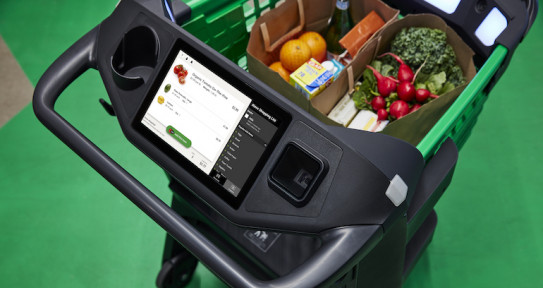
Amazon brings a FRESH perspective to technology in retail
Do you remember when supermarkets began building giant out-of-town superstores? “It will be the death of the high street supermarket shop,” they said.
How about when they replaced some checkouts with shorter versions to cater for customers with 10 items or less? “It will make the queues longer for everyone else!” they said. Self-service tills? “Too complicated, too time-consuming,” they complained. Online food shopping? “It will never work! I’ll always want to pick my own produce!”
In Ealing, London last week, Amazon opened up its first contactless food store outside of the US – Amazon Fresh. Thanks to the very latest ‘depth sensor’ technology and a wealth of cameras in-store, customers are able to scan a QR code on the way in, pick up what they want, put it in their bag and walk out – all without any scanning, queuing, or checkout process involved. Customers are charged later through an Amazon app on their phone.
Amazon says its technology uses ‘computer vision, deep learning algorithms and sensor fusion,’ to enable an efficient and frictionless experience.
“Dystopian” and “scary” are a sample of the adjectives used in UK newspaper headlines after the opening. Customer responses in the media included, “Cashiers will lose their jobs at the worst possible time.”
However, while Redbox CEO Jonty Sutton is excited by the technology Amazon has brought into play, he doesn’t believe we are likely to see rival supermarkets follow suit just yet.
He said: “The tech is incredibly impressive and there’s nothing else like it. From a uniqueness perspective as well as convenience, it’s a million miles away from what anyone else is doing. This is a whole new level from the scan gun.
“However, I don’t think it’s anything to panic about. I can’t imagine that Sainsbury’s, Waitrose or Tesco will be rolling it out en masse in the next 12 months.
“A lot of these brands rely on the human touch and I don’t expect they will want to lose this completely.
“Maybe the self-service tills could become more automated, but I don’t think you’ll see them disappear.”

Jonty Sutton, Redbox's CEO
With data and information at the heart of everything Amazon does, Jonty believes it is the technology that should be the focus of our interest rather than the industry that is using it right now.
He continued: “People will visit for the gimmick factor, but I think the most interesting thing is what’s going on behind the scenes with the data and intelligence.
“Not only do they know lots about you already, but they are now taking it into the physical space too. Clearly it will be scientifically-determined what will be sold in that store at any given time once they get the footfall. They will know the trends of who is buying what and this will get more streamlined the longer people use it.
“I buy the stuff, I walk out; I’ve paid digitally and I don’t interact with anyone. That’s clever in its own right. But what the technology will also do is watch what I’m doing when I’m in the store. The micro-looks. The pauses at certain foods. Where are my hot spots? Am I looking at other products but not picking them up? It will be gathering all of that insight and they’ll adjust the ranges and merchandise, and then you’ll start seeing your online accounts targeted with recommendations.”
Data sharing and personalisation often raise concerns surrounding privacy. How much privacy are we willing to give up for efficiency and convenience?
“I watched a news bulletin that highlighted similar stores opening in India and almost every customer mentioned how many cameras there were in the store,” Jonty continued.
“However, with Amazon being regarded as a data company as much as a retailer, I believe consumers will be more accepting of the cameras in the Amazon Fresh store due to the overall convenience they help provide.
“Google, Amazon and similar are datacentric. As consumers, we are becoming more and more accepting of the slight intrusions into our personal spaces as these companies gain more of our trust. We don’t feel as though we are being exploited by them as much anymore.”
Amazon is believed to be planning 20 more UK Amazon Fresh store openings a year from 2022, with deals already in place for 25 sites.

However, Jonty believes the technology will be used to better effect in the near future.
He added: “For now, it’s saving customers a couple of minutes when buying a few items. Amazon must have done the maths with huge savings in the long-term, but in the short-term the sheer cost of implementing all this technology is incredible. It’s why I don’t believe other supermarkets will follow too quickly.
“But if you think about using this technology in a sports stadium when tens of thousands of people need to get their food or drink quickly at half-time for instance, it makes more sense. You could walk through a turnstile, pick-up what you want without paying and it can all be done digitally when you are against the clock.
“I can see it pushed out more in different situations. If they know more about me and can tailor the experiences to me, it could be really interesting. Online and physical will converge even more.
“Some industries could really benefit from this technology or from going more digital.
“If you have a high number of stores in locations with large volumes of traffic, such as trains stations with large footprints and short bursts of activity, it could be massively-beneficial to get more footfall through a store. Less interaction and quicker transaction times, leading to higher revenue.
“Then you have the personalisation aspect of it. Maybe using this technology in a fashion store would eventually mean they know my name, size, style and can therefore make my experience better, quicker and more streamlined.
“If the tech is taken into the mainstream, it would open up options and conversations and that’s where I think the real future of Amazon Fresh lies.”